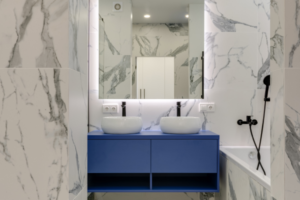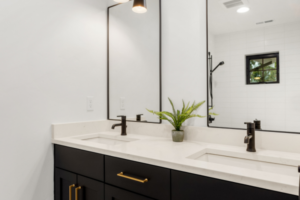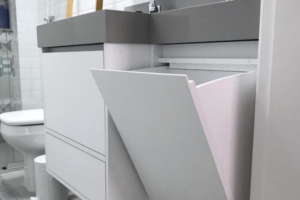In today’s world, sustainability is an increasingly important consideration when designing and renovating homes, including small bathroom spaces. With a growing focus on reducing environmental impact, choosing sustainable materials for custom cabinets can significantly contribute to creating a more eco-friendly bathroom. However, finding the right balance between sustainability, durability, and style can be a challenge, especially in small bathrooms where space is limited and every design element needs to be carefully considered.
When choosing sustainable materials for your custom cabinets, it’s essential to think about the environmental impact of the materials themselves, as well as the processes involved in sourcing, manufacturing, and disposing of them. Fortunately, there are several eco-friendly options available that provide both style and sustainability. Let’s explore some key considerations and the best sustainable materials for custom cabinets in small bathrooms.
Understanding Sustainability in Bathroom Design
Sustainability in bathroom design encompasses the use of materials and practices that minimise harm to the environment. This includes choosing materials that are renewable, recyclable, or made from recycled content, as well as considering the energy efficiency of manufacturing processes and the longevity of the materials used. A sustainable approach also involves selecting materials that have a low environmental impact in terms of production, transport, and disposal.
For small bathrooms, sustainability is especially important because these spaces often require compact solutions that utilise materials efficiently. Custom cabinets allow you to design storage that fits perfectly within the limited space of a small bathroom, while also ensuring that the materials used align with eco-friendly principles.
Reclaimed Wood for a Rustic, Eco-Friendly Aesthetic
Reclaimed wood is an excellent choice for sustainable custom cabinets, especially if you want to add warmth and character to a small bathroom. This material is sourced from old buildings, barns, or furniture that is no longer in use, giving the wood a second life. By using reclaimed wood, you reduce the demand for newly harvested timber, thereby conserving natural resources and lowering the environmental impact associated with logging.
In addition to being an eco-friendly choice, reclaimed wood brings a unique, rustic look to custom cabinets. Each piece of wood has its own distinct history and character, with natural imperfections like knots, grain patterns, and weathering that add to its charm.
Reclaimed wood can be used for both the cabinet structure and the doors, offering a durable and sustainable option for small bathroom cabinets. Since reclaimed wood has already been seasoned and aged, it tends to be more stable and less prone to warping or shrinking, making it an ideal material for high-moisture environments like bathrooms.
Bamboo: A Rapidly Renewable Resource
Bamboo is another sustainable material that is gaining popularity in bathroom cabinetry. As one of the fastest-growing plants on the planet, bamboo is highly renewable and can be harvested in just three to five years, compared to traditional hardwoods that can take decades to mature.
Bamboo is incredibly strong and durable, making it a great choice for custom cabinets in small bathrooms. Its natural resistance to moisture and mould also makes it well-suited to humid environments. In terms of aesthetics, bamboo offers a sleek, modern look with its smooth texture and light, natural colour.
One of the key advantages of bamboo is its versatility. It can be engineered into sheets and boards that are suitable for cabinetry, or it can be used in its natural form for a more organic, textured appearance. Bamboo is also biodegradable, ensuring that it doesn’t contribute to landfill waste at the end of its life cycle.
FSC-Certified Timber for Responsible Sourcing
If you prefer the look of traditional wood for your custom cabinets, opting for FSC (Forest Stewardship Council) certified timber is an excellent way to ensure sustainability. FSC certification ensures that the wood comes from responsibly managed forests that are harvested in a way that preserves biodiversity, prevents deforestation, and supports the local communities that depend on these forests.
FSC-certified timber is available in a variety of wood species, from oak and maple to walnut and cherry. These woods provide a timeless, classic look for custom bathroom cabinets while adhering to sustainable practices. By choosing FSC-certified wood, you can enjoy the beauty and durability of natural wood without contributing to illegal logging or unsustainable forestry practices.
When designing cabinets for small bathrooms, FSC-certified plywood is also an option. Plywood made from certified sources can be used for the cabinet carcasses, providing strength and durability while using less solid wood overall.
Recycled and Reclaimed Metal for a Modern Touch
For a more modern, industrial look, recycled or reclaimed metal can be used for custom cabinet accents or even entire cabinet structures. Metal is a highly durable and long-lasting material that can withstand the humid conditions of a bathroom, making it an excellent choice for cabinets and hardware.
Recycled metal, such as aluminium or steel, has a much lower environmental impact compared to virgin metal, as it requires significantly less energy to produce. Using reclaimed metal from old industrial materials or scrap metal further reduces waste and the need for new mining or extraction.
Custom cabinets with metal doors, frames, or handles can add a sleek, modern edge to your small bathroom, while also contributing to a sustainable design. Metal is also fully recyclable, so when it eventually reaches the end of its life, it can be repurposed without contributing to landfill waste.
Eco-Friendly Laminates for Durability and Style
Laminates are a popular material for bathroom cabinetry because of their durability, moisture resistance, and wide range of design options. However, not all laminates are created equal when it comes to sustainability. If you’re considering laminates for your custom cabinets, look for eco-friendly options made from recycled materials or those that use low-VOC (volatile organic compound) adhesives and finishes.
Recycled laminates are often made from post-consumer or post-industrial waste, such as plastic bottles or scrap wood. These laminates provide the same level of durability and aesthetic appeal as traditional laminates, but with a much lower environmental impact.
Low-VOC laminates are another sustainable choice, as they reduce the emission of harmful chemicals into the air, improving indoor air quality. This is particularly important in small bathrooms where ventilation may be limited. These laminates are available in a wide range of colours, textures, and finishes, making it easy to find a design that complements your bathroom’s style.
Non-Toxic Finishes and Adhesives for Better Indoor Air Quality
When selecting materials for custom cabinets, it’s important to consider the finishes and adhesives used in the construction process. Many traditional finishes and adhesives contain high levels of VOCs, which can off-gas harmful chemicals into the air. This is particularly concerning in small, enclosed spaces like bathrooms, where ventilation may be limited.
To create a healthier bathroom environment, opt for non-toxic finishes and adhesives that are low in VOCs or free from them entirely. Water-based paints, stains, and sealers are a good alternative to traditional solvent-based products, as they emit fewer harmful fumes and have less impact on indoor air quality.
Non-toxic adhesives, such as those made from natural latex or plant-based compounds, are also a sustainable choice. These adhesives provide strong, durable bonds without releasing harmful chemicals into the air. By choosing low-VOC or non-toxic products, you can ensure that your custom cabinets contribute to a healthier living environment while still offering the durability and style you need.
Composite Wood Products with Low Formaldehyde Content
Composite wood products, such as particleboard or MDF (medium-density fibreboard), are often used in bathroom cabinetry because they are affordable and versatile. However, traditional composite wood products can contain high levels of formaldehyde, a chemical that is harmful to both human health and the environment.
If you’re considering composite wood for your custom cabinets, look for products that are CARB (California Air Resources Board) compliant or meet other low-formaldehyde standards. These products are made with adhesives that emit fewer harmful chemicals, improving indoor air quality and reducing the environmental impact.
Additionally, some manufacturers now offer composite wood products made from recycled wood fibres or agricultural waste, further enhancing the sustainability of the material. These options provide a cost-effective and eco-friendly alternative to solid wood, while still offering the durability needed for bathroom cabinetry.
Choosing Local Materials to Reduce Your Carbon Footprint
One often-overlooked aspect of sustainability is the carbon footprint associated with transporting materials. Sourcing local materials for your custom cabinets can significantly reduce the environmental impact of your bathroom renovation by minimising the energy used in shipping and transportation.
Locally sourced materials, such as timber from nearby forests or recycled materials from local suppliers, can also help support the local economy and reduce the overall environmental impact of your project. Additionally, local materials are often better suited to the climate and conditions of your area, ensuring that your custom cabinets are more durable and long-lasting.
Designing for Longevity and Durability
Sustainability isn’t just about the materials you choose—it’s also about designing cabinets that are built to last. By investing in high-quality, durable materials, you can reduce the need for future replacements and renovations, which ultimately conserves resources and reduces waste.
When designing custom cabinets for your small bathroom, prioritise materials that are resistant to moisture, mould, and wear, as these factors can shorten the lifespan of bathroom cabinetry. Durable materials like FSC-certified hardwood, bamboo, and recycled metal are all excellent options that ensure your cabinets will stand the test of time.
Conclusion
Choosing sustainable materials for custom cabinets in small bathrooms not only helps reduce your environmental impact but also creates a healthier, more efficient space. From reclaimed wood and bamboo to eco-friendly laminates and non-toxic finishes, there are many options available that allow you to create stylish, durable cabinets without compromising on sustainability.
By focusing on responsibly sourced materials, low-VOC finishes, and durable designs, you can create a bathroom that is not only functional and beautiful but also kind to the planet. Whether you’re renovating an existing bathroom or building a new one, sustainable cabinetry is a smart choice that benefits both the environment and your home.
FAQs
What is the most sustainable material for bathroom cabinets?
Bamboo, reclaimed wood, and FSC-certified timber are some of the most sustainable materials for bathroom cabinets. These materials are renewable, responsibly sourced, and have a lower environmental impact compared to traditional materials.
Can reclaimed wood be used in a bathroom environment?
Yes, reclaimed wood is highly durable and can be used in bathroom environments. Since it has already been seasoned and aged, reclaimed wood tends to be more stable and less prone to warping, making it an excellent choice for humid spaces like bathrooms.
Are laminates sustainable for bathroom cabinets?
Eco-friendly laminates made from recycled materials or low-VOC adhesives can be a sustainable choice for bathroom cabinets. Look for laminates that are made from post-consumer or post-industrial waste and have been manufactured using environmentally friendly processes.
How do I know if the wood I’m using is sustainably sourced?
Look for FSC (Forest Stewardship Council) certification on any wood products you use. FSC-certified timber ensures that the wood has been sourced from responsibly managed forests that prioritise environmental and social sustainability.
What are the benefits of using non-toxic finishes and adhesives?
Non-toxic finishes and adhesives improve indoor air quality by reducing the emission of harmful chemicals, such as VOCs, into the air. These products are healthier for both you and the environment, especially in enclosed spaces like bathrooms.




